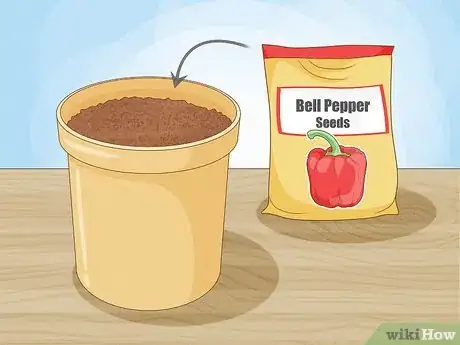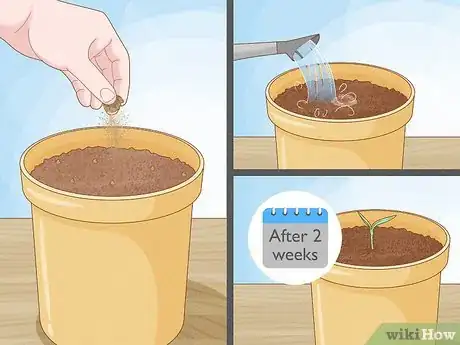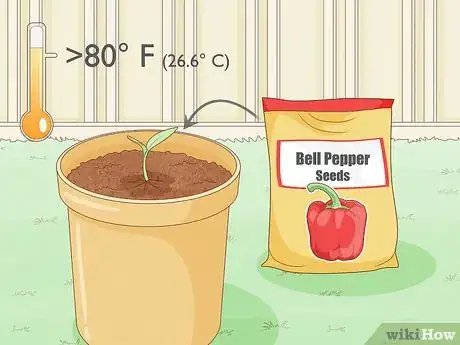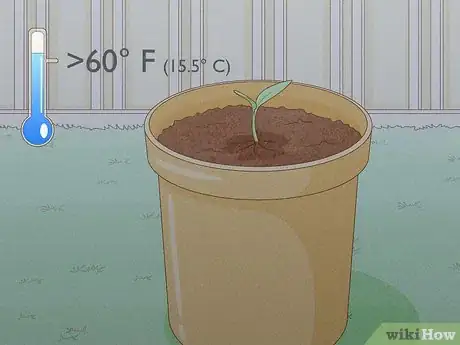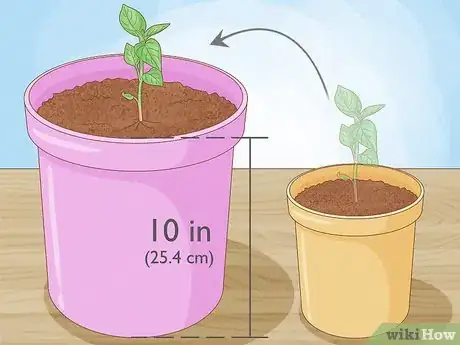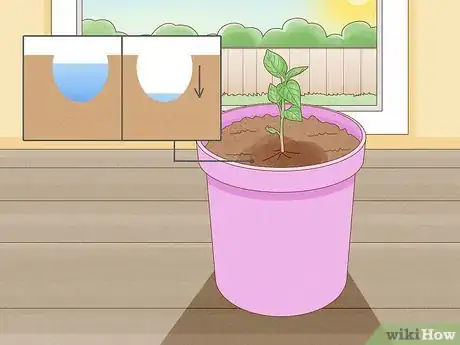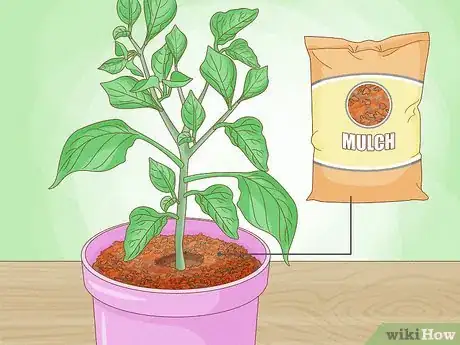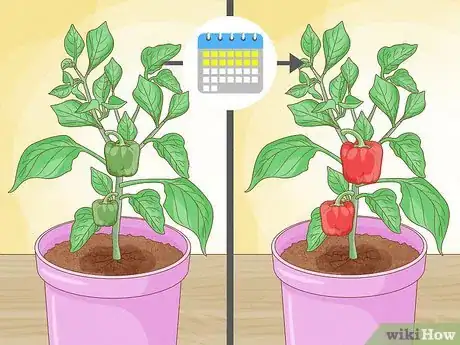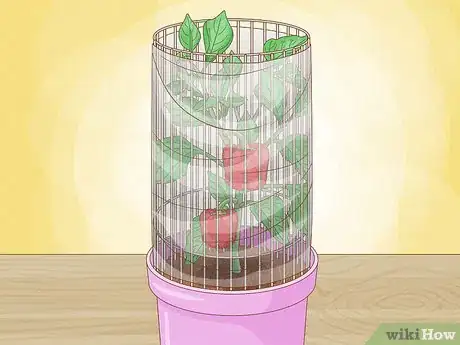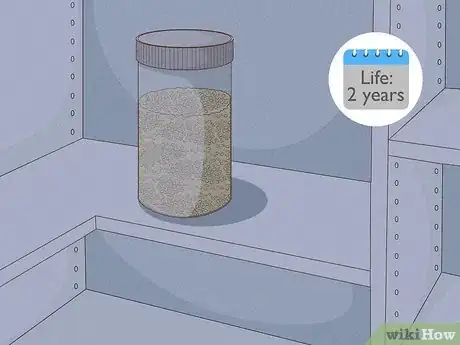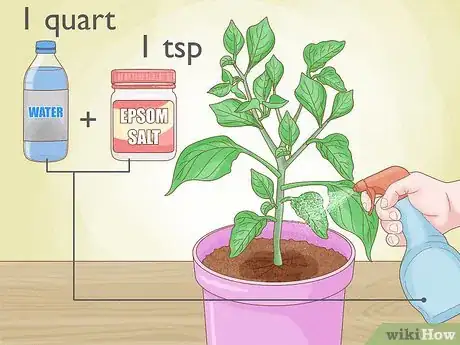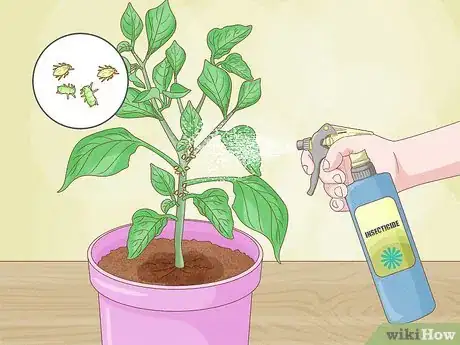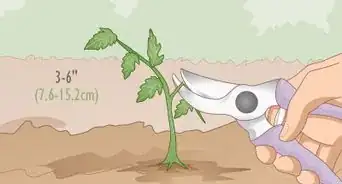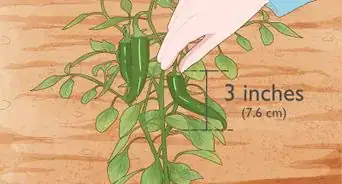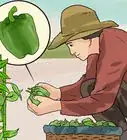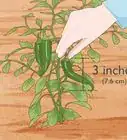This article was co-authored by Jon Rowland. Jon Rowland is a Plant Specialist and the Founder of the Green House Center blog. With over eight years of plant and garden experience, he specializes in greenhouse care, lawn and garden maintenance, and home appliance recommendations. Jon aims to share his knowledge so that others can live a more convenient, efficient, and environmentally friendly lifestyle.
wikiHow marks an article as reader-approved once it receives enough positive feedback. In this case, 90% of readers who voted found the article helpful, earning it our reader-approved status.
This article has been viewed 161,713 times.
Bell peppers (Capsicum annuum) can be a delicious addition to any dish. If you or your family eats a lot of bell peppers, consider growing your own! You can grow bell peppers from seeds, or you can purchase transplants. Either way, you will have soon delicious, homegrown bell peppers that you can be proud of.
Steps
Growing Bell Peppers from Seed
-
1Consider growing bell peppers from seed. While a number of garden centers sell specimens ready for transplanting, bell peppers are relatively easy to grow from seed. Although green, red, yellow, and orange are the most common colors, gardeners also have the option of growing dark brown and purple pepper varieties.
- Some fast ripening varieties can produce fruit in as little as two months but others may need over three months before they begin to flower.
-
2Choose a starting time depending on your local climate. Most bell pepper plants should be started indoors about two months before the frost-free date. Southern gardeners, and gardeners in warm climates with a lengthy growing season, may choose to wait and start their plants outside instead. However, this will naturally affect how soon the plants start producing fruit.Advertisement
-
3Plant the seeds in a light-layer of soil. The bell pepper seeds will need to be lightly covered with soil, then watered. The seedlings should make an appearance within a week or two.
-
4Ensure that the seeds are warm enough. Bell pepper seeds do need a warm period in order to germinate. Plant them in the warm season. By doing this, you can provide bell peppers the right temperature and enough sunlight.[1] Ambient air temperatures of over 80° Fahrenheit (26.6° Celsius) and slightly warmer soil temperatures are recommended for good results.
- Seeds that are slow to sprout may benefit from the use of heating mats.
- Gardeners should note that the plants will not sprout at all if temperatures are below 55° Fahrenheit (12.7° C).
-
5Try to prevent the seedlings from growing too tall and spindly. Seedlings grown indoors need strong light to keep them from becoming tall and spindly. Bad growth at a young stage can affect their overall health and lead to floppy transplants.
- If this is the case no matter what you do, these tiny seedlings can be staked using thin bamboo or wood skewers and tied in place using plain string.
-
6Harden off indoor seedlings before re-planting outdoors. In areas where pepper plants cannot be directly started outdoors, it is a good idea to harden them off once temperatures are regularly over 60° Fahrenheit (15.5° C) at night.
-
7Replant the seedlings into containers once they have grown their first true leaves. Bell peppers do well in containers. They can reach up to 3 feet (0.9 m) in height and width, so gardeners should select a pot that measures about 10 inches (25.4 cm) in depth to keep them from being overcrowded.
-
8Ensure that the seedlings are exposed to the correct growing conditions. These plants require full sun growing conditions and well-drained, fertile soil. They are relatively drought resistant if they are not grown in very small pots.
- Bell peppers can grow well around tomatoes, carrots, eggplants, corns, and cucumbers. Do not plant them near cabbage-related or apricot-related plants because they may develop some fungal disease that may affect their life cycle.[2]
Caring for Bell Peppers
-
1Use black plastic or mulch to control weeds. The former material is also a good way to speed pepper growth in cool climate areas.
- Gardeners in warm climates will want to stick to mulch because it helps conserve moisture and protects the plants’ roots from hot temperatures.
-
2Fertilize the bell pepper plants. These plants benefit from an addition of slow release granular fertilizer, such as Osmocote, or organic varieties, like those made with fish meal or alfalfa.
- However, if one has leafy green plants and no peppers, gardeners should probably cut back on the nitrogen fertilizer.[3] This element is known for producing lush, fruitless plants.
-
3Wait for the bell peppers to ripen before picking. Almost all bell peppers start off green and eventually ripen to the desired color in about two weeks, though some types can take as long as a month for the right color to develop.
- Tall varieties may need to be staked to support the fruit and keep the plants from falling over while the fruit grows and ripens.
-
4Protect the bell pepper plant from sudden drops in temperature. Wire cages wrapped with plastic were mentioned in Mother Earth News article the author read as a good way to insulate tomato seedlings against sudden drops in temperature. Another way to prevent seedling from getting too cold is to use bell jars (hot caps).
- These devices were originally made from glass but now are more likely to be made from leftover plastic milk or soda bottles.
-
5Save the pepper seeds for future planting. Pepper seeds can be saved for up to two years under ideal conditions. This means that growers will not have to purchase seed annually if they store the leftovers in a dark, dry location to keep them from sprouting prematurely.
-
6Get rid of used plants. Once the first chill of winter sets in, gardeners can harvest the remaining fruit and then dig the plants up. Specimens that are not diseased are good candidates for the compost bin.
- Diseased plants can be bagged up and left with the trash to prevent the disease from spreading.
Dealing with Pests and Problems
-
1Use Epsom salts to encourage the plant to bear fruit. Peppers that are having difficulty bearing fruit in warm weather may benefit from being spritzed with a combination of 1 quart water and 1 teaspoon Epsom salts.
- Another idea is to place a tablespoon of Epsom salts in the ground at the base of the pepper plant and cover the material over with dirt so that it can soak in.[4]
-
2Use calcium to deal with blossom end rot. Should gardeners end up with fruits that are black at the ends, a condition known as blossom end rot, they will need to find a way to add more calcium to their soil. The simplest way to do this is by watering affected pepper plants with any milk that expires in the fridge.
- Small amounts of soured milk can be mixed up with water if there wouldn’t be enough to use on every plant.
-
3Spray the plant with water or insecticides to get rid of aphids. Aphids are a typical garden pest that can be removed temporarily by a hard spray of water. Organic gardeners may want to try these bugs with neem or pyrethrum based sprays.
- Repeated applications may be necessary as these garden menaces are especially hard to eradicate.
- You can stake them higher from the ground to keep them away from pests.[5]
-
4Protect your plants from cold or hot temperatures. Temperatures below 65° or above 95° can keep peppers from producing fruit. If it is just a minor cold spell or heat wave, they will resume production once it has passed.
- Keep in mind that cold temperatures are especially bad for the health of peppers. Those exposed to extremely chilly weather may not recover from the experience, so it may be advisable to bring them indoors until the temperatures have warmed back up.
Community Q&A
-
QuestionWhy are my bell pepper leaves turning yellow?
 Community AnswerIt could be due to either a lack of water or nutrients. Try watering your peppers more frequently. If that doesn't correct the problem, add some nutrients to the soil.
Community AnswerIt could be due to either a lack of water or nutrients. Try watering your peppers more frequently. If that doesn't correct the problem, add some nutrients to the soil. -
QuestionWhy do the flowers keep falling off and not producing?
 Community AnswerAdd some fertilizer! The lack of water/pollination can contribute to bad flowering, thereby rendering your peppers unable to grow.
Community AnswerAdd some fertilizer! The lack of water/pollination can contribute to bad flowering, thereby rendering your peppers unable to grow. -
QuestionI have grown bell peppers in my unheated greenhouse in Zone 5 the past few years, with poor results. The flowers drop off and very few flowers develop into peppers. What am I doing wrong?
 Community AnswerIf you are in a green house, your plants may not be being pollinated. Try pollinating by hand.
Community AnswerIf you are in a green house, your plants may not be being pollinated. Try pollinating by hand.
References
- ↑ Jon Rowland. Plant Specialist. Expert Interview. 7 September 2021.
- ↑ Jon Rowland. Plant Specialist. Expert Interview. 7 September 2021.
- ↑ Jon Rowland. Plant Specialist. Expert Interview. 7 September 2021.
- ↑ http://www.motherearthnews.com/organic-gardening/how-to-grow-red-peppers-zmaz03fmzgoe.aspx#axzz3FfrCnETR
- ↑ Jon Rowland. Plant Specialist. Expert Interview. 7 September 2021.
About This Article
To grow bell peppers, start by planting bell pepper seeds indoors 2 months before the last expected frost. Then, once the seedlings sprout and grow their first true leaves, transplant them into containers. Keep the containers in a sunny spot, and fertilize them with a slow-release granular fertilizer to help them grow. Once the bell peppers grow and ripen, you can start to harvest them. For tips on how to deal with common pests and problems that affect bell peppers, scroll down!
